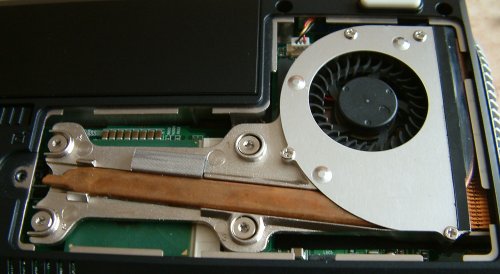More analysis

Speaking of ODMs, it appears that Arima provides the chassis and basic architecture for the Razor line, which is identified as an M620-DC here. What's good is immediate support for the new Dothan processor which carries a prodigious, performance-enhancing 2MB of L2 cache. Surely Intel should release it as a desktop model, too?.

The right-hand slot contains 2x512MB PC3200 SODIMMs. The Banias platform uses PC2100 memory, but there's negligible price between the modules specified and PC2100 RAM. We suppose it adds a sense of futureproofing to the package. 1GB makes the SavRow Razor 1.7 purr along ever so nicely in Windows XP Home. The middle slot covers Intel's 802.11g-compliant Wireless mini-PCI card. Wireless connectivity is an inherent feature of the Centrino brand, so it's nice to have 54g usage immediately.

The top-right portion is reserved for CPU cooling. Arima / SavRow use a small fan allied to a heatpipe design. This is the only fan in the machine and it's unobtrusive when the processor is under full load. In fact, one of the Razor 1.7's key attributes is a lack of operation noise. It' not listed on the specifications page but it's a worthy feature in its own right. Kudos to the chassis designers for engineering such an efficient solution. The Razor's 6-cell battery gives out around 3000mAh. We'll talk more about battery life later.

There's not much key travel on the SavRow Razor. That's down to the laptop's space-saving design. I found the keys to be responsive and the travel to be predictable across the range. Due to space limitations, a function key adds dual usage to a number of keys, which is shown in blue. In particular, one can use it to toggle Wireless on and off and change screen brightness. There's also a couple of shortcut keys on the top left-hand side. A larger picture of the open laptop can be found here.

The very front has a couple of buttons that work like any mouse's and lights that show various levels of activity. It's a shame there's no display here, as it would be perfect as an audio player when in standby or switched-off mode. Having said that, the Razor 1.7's sound ability is akin to a £10 clock radio's; it's tiny and lacks bass. SavRow has a raised plastic sticker on the left-hand side. Whilst it undoubtedly looks good, anyone with large-ish hands who touch-types will find it getting, really annoyingly, in the way, right underneath your left palm.
Our review model featured a 15" SXGA (1400x1050) TFT screen that crisp and clear at its native resolution. Even non-native resolutions were up to scratch. What could be improved, though, was the poor viewing angle. Anything over 30° in either direction led to a dramatic loss in clarity and colour. We'd also like the Razor-series to be available with a widescreen TFT, something along the line of Dell's Inspiron 8600c, for example. That may become reality soon, as Arima provides a compliant chassis.
Total travel weight is an important issue for a thin-and-light laptop. SavRow keeps it down to around 2.5kg by specifying a tiny 60w charger. The retail bundle is yet to be announced but will feature a deluxe laptop bag at the very least. SavRow provides a 3-year collect and return warranty, which is norm for consumer laptops.
£1469 buys you potent power in a sleek, svelte, sexy laptop. We'd swap out the optical drive for a DVD-ReWriter and push the price up to £1500. There's a lot to like here, from ATI's excellent Mobility Radeon 9700 to an 80GB hard drive, 54g Wireless, and decent, vibrant screen. The most alluring single feature has to be the sandwiching of such power components into a thin-and-light chassis. We've taken a visual look. Let's now take a benchmark look and evaluate the Razor 1.7's performance against other power laptops we've reviewed recently.









